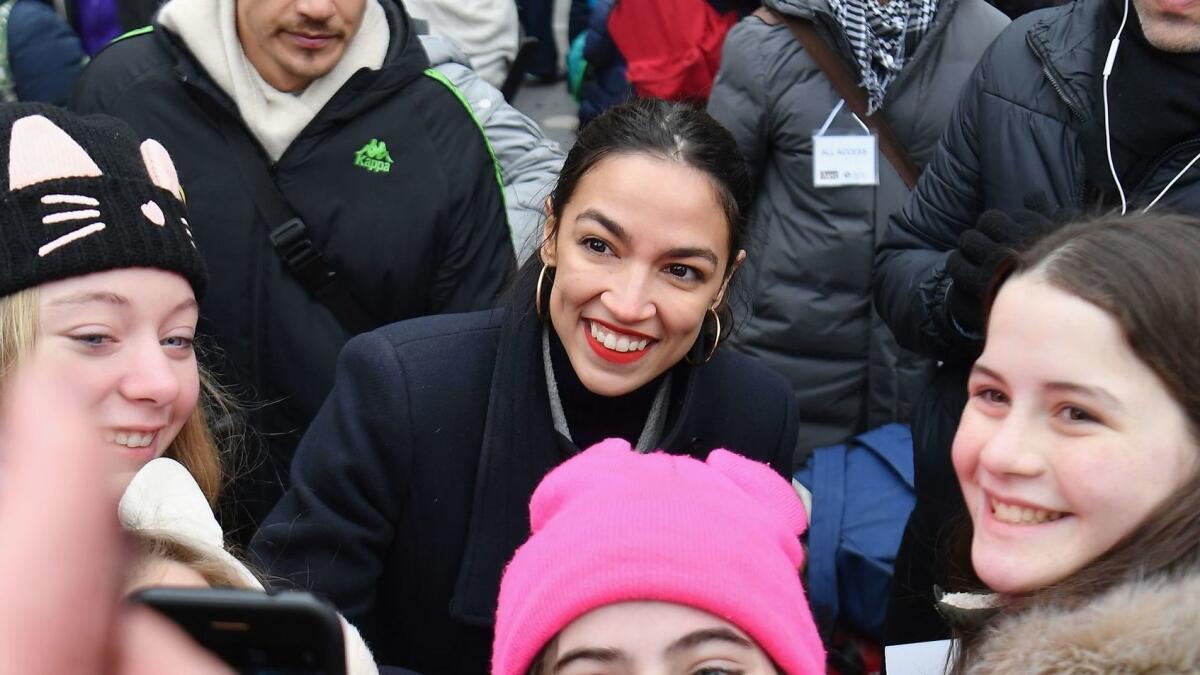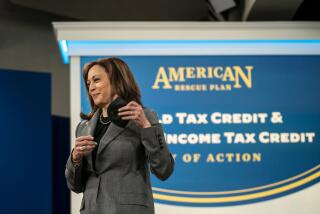Column: Here are all the things Alexandria Ocasio-Cortez’s critics get wrong about federal taxes

The comments by newly minted Congresswoman Alexandria Ocasio-Cortez (D-N.Y.) calling for higher taxes on the rich continue to reverberate in public discussion, two weeks after they were broadcast on “60 Minutes.”
That’s enough time for conservative criticisms of Ocasio-Cortez’s remarks to gel. And that, in turn, gives us an opportunity to examine them and show how they’re wrong.
First, let’s briefly examine why these remarks by the first-term politician known commonly as AOC generates so much pushback. One reason surely is that the establishment is rattled by a newcomer so skilled at using modern communications techniques — social media, that is — to challenge establishment thinking. Another is that in her comments on taxation, she’s striking at the most important privilege enjoyed by the rich patrons of conservative and Republican office-holders: preferential tax rates.
People are going to have to start paying their fair share in taxes.
— Rep. Alexandria Ocasio-Cortez
And now to the gist. One of the most common themes of AOC’s critics is that her proposal to levy a 70% marginal rate on incomes over $10 million simply won’t bring in that much revenue — certainly not enough to fund the shift to zero carbon emissions she calls for as part of a “Green New Deal.”
That’s true. A $10-million top tax bracket would cover only about 16,000 U.S. households. By well-reasoned estimates, it would bring in an additional $30 billion a year averaged over 10 years. That’s not much for a federal budget of $4.4 trillion, and surely not enough to pay for the dramatic change Ocasio-Cortez advocates.
Or rather, it would be true, if Ocasio-Cortez actually proposed a top tax rate of 70% on incomes over $10 million and left it at that. She did nothing of the kind, as anyone can see by examining the “60 Minutes” transcript with eyes in their head.
What she called for, actually, was reversing the trend toward a less progressive tax structure that we’ve seen since the 1960s. The gist of her idea was that “people are going to have to start paying their fair share in taxes.”
Her interviewer, Anderson Cooper, asked her for a “specific on the tax rate,” but in her answer she plainly talked about a progression of higher rates leading up to a top rate of 70%. It’s obvious from the transcript that she was using a 70% top rate on the $10-million-plus crowd as an example, not a one-off proposal.
As we reported previously, some conservative critics have treated Ocasio-Cortez’s words as if she proposed taxing all income of those earning $10 million or more at 70%. We’ve already explained that almost certainly they’re deliberately lying.
Some critics have argued that Ocasio-Cortez’s reference to the much higher marginal rates of the 1960s is misleading, because no one actually paid those rates — the wealthy had access to tax deductions that have been eliminated since then.
That’s true up to a point, but the fact is that the wealthy don’t pay the top marginal rate today, either. Some tax shelters have been eliminated, but the biggest one of all — the preferential tax rate on capital gains — is still with us. And with the wealthy declaring 50% or more of their income as capital gains, the preferential rate is the tax reform hill they’re willing to die on. As we’ve shown, except for a brief period about 1989, in the postwar period capital gains have always been taxed at less than the top marginal rate on wage and salary income.
So let’s move on to the broader question of the progressivity of the U.S. tax system. Ocasio-Cortez is absolutely correct in observing that federal taxes have become much less progressive in recent decades, following a series of tax cuts for the upper crust dating back to the Reagan years.
This was documented in 2007 by Emmanuel Saez of UC Berkeley and Thomas Piketty. They found, for instance, that the average tax rate on the top 0.1% had fallen from 31.5% in 1970 to 25.1% in 2004. (That stratum of taxpayers would kick in today at about $3.4 million in income.) The average tax rate on these taxpayers is undoubtedly lower today, following the GOP tax cut of 2016. Note that this is the average tax rate on those households, not the top marginal rate.
Overall, Saez and Piketty showed, federal individual tax rates in the U.S. have dramatically flattened out since 1970, to the point where the top 1% pay barely a higher rate than the bottom 90%.
Advocates of lower tax rates on the rich typically tie tax cuts to higher economic growth. It’s somewhat amazing that they still say this, because it’s been exposed as a canard over and over again.
The nonpartisan Congressional Research Service observed in 2012, for example, that in the 1950s, when the top marginal income tax rate was 91%, real economic growth averaged 4.2% a year, and that in the 2000s, when the top marginal rate was 35%, real growth averaged only 1.7%.
But its main finding was that the connection between the top tax rates and growth was weak. Broad-based tax cuts like the Bush cuts of 2001 and 2003 have “no effect on economic growth,” the CRS reported, and that therefore it would be reasonable to assume that the impact of more narrowly based cuts, such as the Republican cuts of 2016, also would be “negligible.”
What about the behavioral response to higher rates — that is, how do taxpayers react? This is where conservative tax analysts reach new heights of absurdity.
In an online debate at Bloomberg.com a few days after the Ocasio-Cortez interview, Michael Strain of the conservative American Enterprise Institute conjectured that with a 70% top rate “a young person interested in health care might decide to become a nurse rather than a surgeon, because much of the income gained from being a surgeon will be taken by the government….This sort of tax-driven inefficiency makes society worse off.”
Right. Raise your hand if you’ve ever met a student deciding not to become a doctor because they make just too damn much money — outside the airy fantasies of conservative economists, that is. Anyone? Anyone? Bueller?
It’s much more likely, the CRS asserted, that higher marginal rates would produce less income inequality, because those at the top end of the income ladder would feel less incentive to feather their nests beyond the point they need the money.
“For example,” the CRS wrote, “a CEO has less incentive to bargain hard over additional compensation when he keeps 9 cents of every additional dollar (a 91% top tax rate) than when he keeps 65 cents of every additional dollar (a 35% top tax rate).” The CRS added that 60% of taxpayers in the top 0.1% echelon were in jobs that gave them some scope for such negotiations, including executives and finance professionals, which suggests that they, not nursing or medical students, would factor the top rate into their employment decisions.
Undoubtedly, this discussion will continue, because Ocasio-Cortez has put the progressivity of federal taxes on the table and her critics will never let it go. Thus far, they’ve gotten every point wrong, and the chances they’ll start getting it right are nil.
Keep up to date with Michael Hiltzik. Follow @hiltzikm on Twitter, see his Facebook page, or email [email protected].
Return to Michael Hiltzik’s blog.
More to Read
Get the L.A. Times Politics newsletter
Deeply reported insights into legislation, politics and policy from Sacramento, Washington and beyond. In your inbox three times per week.
You may occasionally receive promotional content from the Los Angeles Times.











